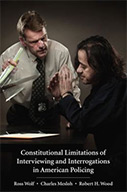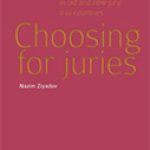Constitutional Limitations of Interviewing and Interrogations in American Policing

Authors: Ross Wolf, Charles Mesloh, and Robert H. Wood.
Publisher: Durham, NC: Carolina Academic Press, 2013. 141p.
Reviewer: Craig Hemmens | November 2013
One of the primary, if not the primary, means by which law enforcement officers secure sufficient evidence to prosecute someone for a crime is through interviews and interrogations. Physical evidence and eyewitness identifications are others, but these are neither as common as television dramas such as CSI: Miami and Law and Order would have us believe. DNA evidence and fingerprints are often not available, and many crimes have no witnesses other than the suspect and victim. Because interrogations are so often central to a successful prosecution, police officers have, not surprisingly, gone to great lengths to make the most of them. Historically, this has not infrequently resulted in the police violating constitutional safeguards. Recent scholarship on wrongful convictions indicates that false confessions are often prompted by police overreaching (Garrett, 2011).
The United States Supreme Court tried for many years to reduce police misconduct, requiring in a series of cases that interrogations be voluntary and not coerced. Finally, in Miranda v. Arizona (1966), the Court crafted what it thought would be a set of clear guidelines for police and suspects. As with so many Supreme Court attempts to create a bright-line rule that would cover all situations, however, it turned out there was still quite a bit of room to maneuver for clever police offers looking to obtain a confession or incriminating statement. Since Miranda, the Supreme Court has repeatedly revisited the interrogation room and attempted to clarify what the police can do, when they can do it, and how they can do it. The result is a large and often confusing body of law regarding when and how police may speak with suspects.
In Constitutional Limitations of Interviewing and Interrogations in American Policing, coauthors Ross Wolf, Charles Mesloh, and Robert Wood attempt to provide a concise summary of the law of interrogations and some related areas, including stop and frisk, vehicle searches, and polygraph testing. The authors bring a considerable wealth of experience, both academic and practical, to the project. Two are former police officers and one has a law degree; all have taught in the area. Their goal is a commendable one—to provide police officers and criminal justice students with an overview of the law in these areas. Sadly, they only partially reach their goal.
This brief book (less than 130 pages of text) includes six chapters. In Chapter One, the authors provide an overview of the criminal justice system that is too brief to be of much use except to those with absolutely no exposure to the criminal justice system. The later part of this chapter covers the components of the interrogation and contrasts it with an interview. This material, while also quite brief, is more useful to those who want a deeper understanding of how interrogations are conducted.
Chapter Two includes a summary of five significant cases dealing with police interrogation practices, culminating in a discussion of Miranda v. Arizona. These case summaries, while interesting, do not add much to the book, as they often consist of extended quotations from the Supreme Court decision. The authors provide a very short explanation of the importance of these cases, which is helpful. More in this area would have added to the book’s usefulness.
Chapter Three includes a summary of most of the important Supreme Court decisions that followed and built upon Miranda. As in Chapter One, these case summaries are mildly interesting but add little of substance to the book. The authors provide a short explanation of why the case is important, but this could be reached without all the case details that really are not necessary, and which have been well-covered in other books aimed at criminal justice students, such as del Carmen and Walker’s Brief of Leading Cases in Law Enforcement (2011).
Chapter Four focuses on the constitutional limitations on interviewing juveniles. It shares the merits and demerits of the previous two chapters. In Chapter Five, the authors turn their focus to stop and frisk, consensual encounters, and vehicle searches and seizures. Chapter Six examines polygraph testing. Both of these chapters seem like filler, as their subject matter does not fit with the title and expressed goals of the book. Furthermore, the chapters are far too short to cover these topics in the detail required—the chapter on polygraph testing is twelve pages, and the chapter on stop and frisk and other police investigatory practices takes a mere twenty pages to cover an incredibly complex series of topics.
There exists a plethora of books dealing with police investigatory practices. These range from standard textbooks to legal treatises, as well as a number of books that attempt to provide a concise yet accurate guide to the constitutional limitations on police practices. These books serve an important purpose, as they assist criminal justice students and law enforcement officers in understanding a very complex area of the law. The authors of Constitutional Limitations of Interviewing and Interrogations in American Policing have attempted to do the same, but unfortunately have fallen far short of their goal. The book is simply too short—it lacks sufficient depth and coverage, and it seems patched together. A book on the rules covering interrogations would be sufficient in and of itself; the addition of the last two chapters is a poor fit and feels like an effort to make the book a bit longer. I encourage people interested in learning more about the law of interrogations to start with Inbau and colleagues’ seminal work on the subject (2011). While it is a much longer work, it is also a much more useful one. Brevity, while a commendable goal in general, cannot be achieved at the cost of detailed explanation of a complex subject.
References
del Carmen, Rolando, Walker, Jeffery T. 2011. Briefs of Leading Cases in Law Enforcement (8th edition). Waltham, MA: Anderson.
Garrett, Brandon L. 2011. Convicting the Innocent: Where Criminal Prosecutions Go Wrong. Cambridge, MA: Harvard University Press.
Inbau, Fred E., Reid, John E., Buckley, Joseph P., and Jayne, Brian C. 2011. Criminal Interrogation and Confessions (5th edition). New York: Jones & Bartlett.
Miranda v. Arizona, 384 U.S. 436 (1966).
Craig Hemmens is Professor in the Department of Criminal Justice and Criminology at Washington State University


